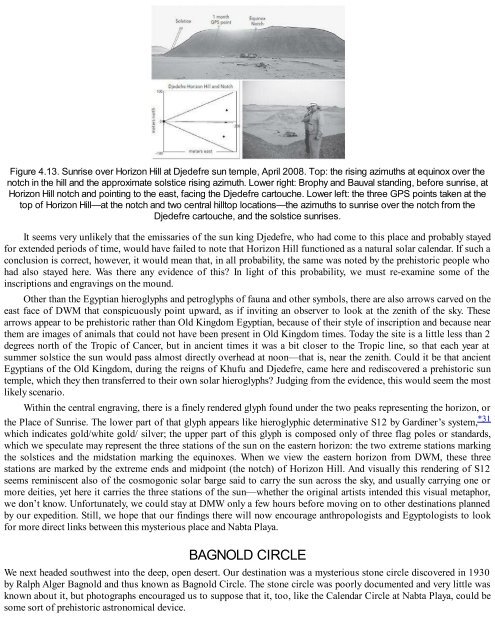Black Genesis: The Prehistoric Origins of Ancient Egypt
Black Genesis: The Prehistoric Origins of Ancient Egypt
Black Genesis: The Prehistoric Origins of Ancient Egypt
You also want an ePaper? Increase the reach of your titles
YUMPU automatically turns print PDFs into web optimized ePapers that Google loves.
Figure 4.13. Sunrise over Horizon Hill at Djedefre sun temple, April 2008. Top: the rising azimuths at equinox over the<br />
notch in the hill and the approximate solstice rising azimuth. Lower right: Brophy and Bauval standing, before sunrise, at<br />
Horizon Hill notch and pointing to the east, facing the Djedefre cartouche. Lower left: the three GPS points taken at the<br />
top <strong>of</strong> Horizon Hill—at the notch and two central hilltop locations—the azimuths to sunrise over the notch from the<br />
Djedefre cartouche, and the solstice sunrises.<br />
It seems very unlikely that the emissaries <strong>of</strong> the sun king Djedefre, who had come to this place and probably stayed<br />
for extended periods <strong>of</strong> time, would have failed to note that Horizon Hill functioned as a natural solar calendar. If such a<br />
conclusion is correct, however, it would mean that, in all probability, the same was noted by the prehistoric people who<br />
had also stayed here. Was there any evidence <strong>of</strong> this? In light <strong>of</strong> this probability, we must re-examine some <strong>of</strong> the<br />
inscriptions and engravings on the mound.<br />
Other than the <strong>Egypt</strong>ian hieroglyphs and petroglyphs <strong>of</strong> fauna and other symbols, there are also arrows carved on the<br />
east face <strong>of</strong> DWM that conspicuously point upward, as if inviting an observer to look at the zenith <strong>of</strong> the sky. <strong>The</strong>se<br />
arrows appear to be prehistoric rather than Old Kingdom <strong>Egypt</strong>ian, because <strong>of</strong> their style <strong>of</strong> inscription and because near<br />
them are images <strong>of</strong> animals that could not have been present in Old Kingdom times. Today the site is a little less than 2<br />
degrees north <strong>of</strong> the Tropic <strong>of</strong> Cancer, but in ancient times it was a bit closer to the Tropic line, so that each year at<br />
summer solstice the sun would pass almost directly overhead at noon—that is, near the zenith. Could it be that ancient<br />
<strong>Egypt</strong>ians <strong>of</strong> the Old Kingdom, during the reigns <strong>of</strong> Khufu and Djedefre, came here and rediscovered a prehistoric sun<br />
temple, which they then transferred to their own solar hieroglyphs? Judging from the evidence, this would seem the most<br />
likely scenario.<br />
Within the central engraving, there is a finely rendered glyph found under the two peaks representing the horizon, or<br />
the Place <strong>of</strong> Sunrise. <strong>The</strong> lower part <strong>of</strong> that glyph appears like hieroglyphic determinative S12 by Gardiner’s system, *31<br />
which indicates gold/white gold/ silver; the upper part <strong>of</strong> this glyph is composed only <strong>of</strong> three flag poles or standards,<br />
which we speculate may represent the three stations <strong>of</strong> the sun on the eastern horizon: the two extreme stations marking<br />
the solstices and the midstation marking the equinoxes. When we view the eastern horizon from DWM, these three<br />
stations are marked by the extreme ends and midpoint (the notch) <strong>of</strong> Horizon Hill. And visually this rendering <strong>of</strong> S12<br />
seems reminiscent also <strong>of</strong> the cosmogonic solar barge said to carry the sun across the sky, and usually carrying one or<br />
more deities, yet here it carries the three stations <strong>of</strong> the sun—whether the original artists intended this visual metaphor,<br />
we don’t know. Unfortunately, we could stay at DMW only a few hours before moving on to other destinations planned<br />
by our expedition. Still, we hope that our findings there will now encourage anthropologists and <strong>Egypt</strong>ologists to look<br />
for more direct links between this mysterious place and Nabta Playa.<br />
BAGNOLD CIRCLE<br />
We next headed southwest into the deep, open desert. Our destination was a mysterious stone circle discovered in 1930<br />
by Ralph Alger Bagnold and thus known as Bagnold Circle. <strong>The</strong> stone circle was poorly documented and very little was<br />
known about it, but photographs encouraged us to suppose that it, too, like the Calendar Circle at Nabta Playa, could be<br />
some sort <strong>of</strong> prehistoric astronomical device.


